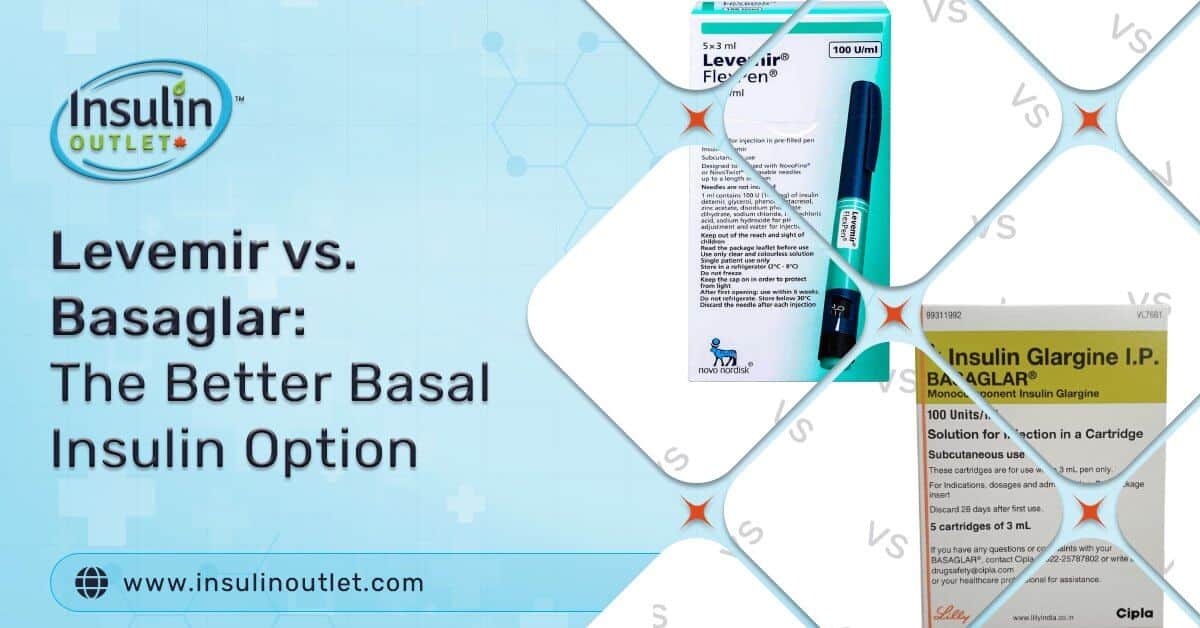
Today’s insulin matchup is Tresiba vs Lantus! Just in case you haven’t heard of these two brands, they are medications used to treat people with Type 1 and Type 2 diabetes. Tresiba is insulin degludec, while Lantus is insulin glargine, and they are long-acting insulins that remain in the bloodstream long after it is injected. Although people believe they are similar due to their duration, they do have quite a few differences. Doctors prescribe these insulin medications to control blood sugar levels in diabetic patients. In this article, we review both of them in great detail.
Table Of Contents
Toggle- What is Tresiba and What is Lantus ?
- Tresiba vs. Lantus: Let the Battle Begin!
- Essential ingredients in Lantus and Tresiba
- How are Tresiba and Lantus Used?
- Tresiba vs. Lantus: Dosage/Forms/Application
- Tresiba FlexTouch Pens 200 Units / mL
- Tresiba FlexTouch Pens 100 Units/mL
- Lantus Vials (100 Units/mL)
- Lantus Solostar Pens (100 Units/mL)
- Who Should Avoid Tresiba and Lantus?
- Final Thoughts
What is Tresiba and What is Lantus ?
Before we get into to the main event, it would be best to have a quick glimpse at each competitors background.
Tresiba
Tresiba is an insulin drug that begins to take effect several hours after it is injected into the bloodstream. Tresiba contains a very active agent called insulin degludec, that works in a similar fashion to the natural insulin produced by the pancreas. Tresiba can be injected with FlexTouch pens (100 units and 200 units) under the skin. Many diabetics prefer the use of injection pens over the traditional vial and syringe method.
Lantus
Lantus is another injectable drug taken once a day to reduce blood sugar or to prevent spikes in the bloodstream. Also known as insulin glargine, Lantus can be used as an independent drug or combined with other drugs. Unlike Tresiba, Lantus begins to take effect once it is injected and remains in the bloodstream. Lantus is also available through injectable pens, called SoloStar Pens.

Tresiba vs. Lantus: Let the Battle Begin!
Tresiba and Lantus have certain similarities and differences that you should be aware of.
Similarities
Both of them are injectable solutions administered using an injection pen or a syringe. They are injected just under the skin and only administered once a day.
Taking Tresiba and Lantus at regular intervals is very important, so users are advised to take them at the same time every day. They both have similar functionality through their injection pens and cartridges.
Another similarity has to do with the ailment they treat. As mentioned, Tresiba and Lantus are used to help diabetics to control glucose spikes in the bloodstream.
Differences
Tresiba and Lantus may be used to control blood sugar levels, but they have certain differences. For starters, Lantus and Tresiba remain in the bloodstream for a long time, but Tresiba remains effective for a much longer time compared to not just Lantus but most of the other long-acting insulin on the market today. While Lantus can remain active for up to 24 hours after it is injected, Tresiba lasts for up to 42 hours. This best explains why Tresiba costs more than Lantus. Released in 2015, Tresiba costs double the amount of Lantus released in 2000. They also have different side effects; Tresiba may cause fever, diarrhea or body aches, while Lantus may cause anxiety, blurred vision and confusion.
Essential ingredients in Lantus and Tresiba
These medications have different active agents. Tresiba had insulin degludec while Lantus contains insulin glargine. Long-lasting insulin means they work to keep the level of blood sugar steady for as long as they remain active in the bloodstream.
How are Tresiba and Lantus Used?
Tresiba and Lantus are prescribed for the management of blood sugar levels. Here is a quick summary of what they are used to treat.
Tresiba is used for managing blood sugar levels in children ages 1 and older adults who have Type 1 or Type 2 diabetes
Lantus is used to manage blood sugar levels in kids and adults with the minimum age requirement pegged at 6 years and above. Lantus can be used to manage blood sugar in Type 1 diabetes patients.
Tresiba vs. Lantus: Dosage/Forms/Application
Tresiba and Lantus are sold in liquid solutions and come in different forms, namely;
Vials: The vial contains insulin, and to extract it, you use a new string and needle.
Prefilled pens: For the prefilled pens, the insulin is already inside the pen and just like the vial, you need a new needle to administer it. Prefilled pens and only used once or should not be used at all if the content inside the pen expires. As mentioned above, Tresiba prefilled pens are branded as FlexTouch, while Lantus is named SoloStar.

Factors That Determine Dosage
There are so many factors that determine the dosage, namely:
- The Age of the user
- Weight
- Current insulin already in use
Switching Between Lantus and Tresiba
One common question many ask, is if it’s proper to switch between one medication to another, i.e. switching between Tresiba to Lantus or vice-versa. The answer is yes, but it all depends on your doctor’s directions. Choosing to switch from one medication to another, without expert direction is dangerous and may lead to low or high blood sugar, which may lead to severe symptoms and even death. That is why diabetic medications should only be taken under strict prescription and guidance of a medical expert.
Hyperglycemia (high blood sugar) and hypoglycemia (low blood sugar) are possible effects of switching drugs. This is because Tresiba has a much stronger and longer effect than Lantus.
In the event that your doctor decides to recommend switching medications, they will watch how your system reacts to the new drug. If feel strong side effects, you may be asked to adjust your dosage to reduce. Dosage prescriptions by doctors depends on three things:
- Insulin strength
- Manufacturer
- Mode of administration
Also, note the following:
- When switching from Tresiba to Lantus, you will need to adjust your dosage because Lantus does not remain active for as long as Tresiba.
- Switching from Lantus to Tresiba will require the same number of daily shots.

Side Effects of Tresiba and Lantus
Both drugs are known to cause side effects in some patients, and these effects are largely similar. They include:
- Headaches
- Indigestion
- Nausea
- Dizziness
- Blurry vision
The good news is that the side effects can be managed, and they are often mostly mild.
How Effective are Tresiba and Lantus?
Tresiba and Lantus are very effective for managing blood sugar in people with diabetes. The American Diabetes Association recommends both medications because they are very effective. . But the general consensus among experts is that Tresiba is far more effective than Lantus because it protects the system over night. But overall, they are very good medications for keeping blood sugar under control.
Who Should Avoid Tresiba and Lantus?
These medications may be effective for managing Type 1 and Type 2 diabetes, but they are not healthy for all people with diabetes with a chequered medical history. By this, we mean people who have certain pre-existing conditions already affecting their health. If you have any of the following conditions, these medications may not be good for you; therefore, talk to your doctor before you even consider using them
- Hypoglycaemia (low blood sugar
- Hypokalemia (low potassium level)
- Pre-existing liver or kidney problems
- Pregnancy
- Thiazolidinediones
- Drug reaction allergies
- Breastfeeding
- Pregnant women
Since they work in the same way and have similar side effects, your doctor may prescribe one or the other. If you suffer from hypoglycaemia often, your health care professional may prescribe Tresiba for night use instead of Lantus because it remains active for much longer than. Common questions you may want to ask include
Final Thoughts
Tresiba and Lantus are two long-acting insulin medications, used to manage blood sugar in patients with Type 1 and Type 2 diabetes. Of the two, Tresiba lasts much longer than Lantus, Wth the former lasting up to 42 hours while the latter lasts for up to 24 hours. Please note we are not promoting self-medication and it is completely ill-advised. Before you take any of these drugs, it is imperative that you contact your healthcare professional, who will examine your condition and decide whether any of them would be appropriate for you.

Share:












